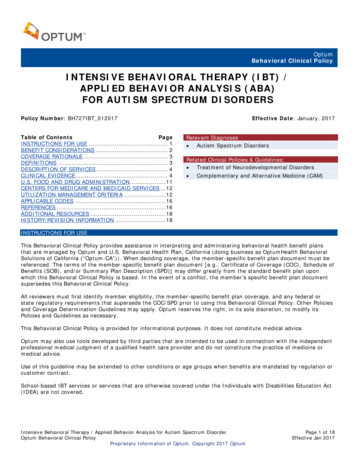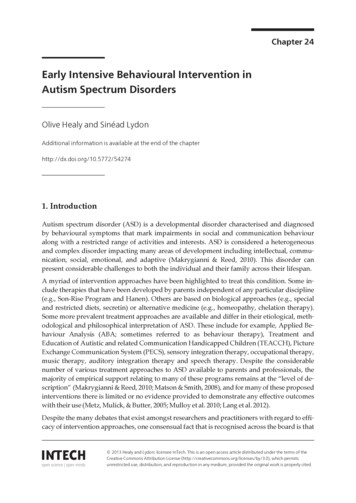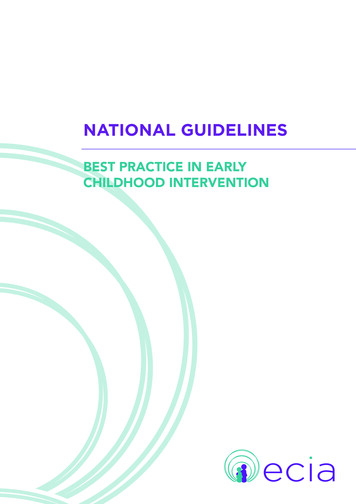
Transcription
Campbell Systematic Reviews2014:9First published:Search executed:03 November, 201422 November, 2011Early Intensive BehavioralIntervention (EIBI) forYoung Children with AutismSpectrum Disorders (ASD):A Systematic ReviewBrian Reichow, Erin E Barton, Brian A Boyd, Kara Hume
ColophonTitleAuthorsDOINo. of rs forthis reviewSupport/fundingPotential conflictsof interestEarly Intensive Behavioral Intervention (EIBI) for Young Children withAutism Spectrum Disorders (ASD): A Systematic ReviewBrian Reichow1Erin E Barton2Brian A Boyd3Kara Hume41Child Study Center, Yale University School of Medicine, USA.2School of Education and Human Development,University of Colorado Denver, USA3Division of Occupational Science and Occupational Therapy, Departmentof Allied Health Sciences, University of North Carolina at Chapel Hill, USA.4Frank Porter Graham Child Development Institute, University of NorthCarolina at Chapel Hill, USA10.4073/csr.2014.9116Reichow B, Barton EE, Boyd BA, Hume K. Early Intensive BehavioralIntervention (EIBI) for Young Children with Autism Spectrum Disorders(ASD): A Systematic Review. Campbell Systematic Reviews 2014:9DOI: 10.4073/csr.2014.91891-1803This review is co-registered within both the Cochrane and CampbellCollaborations. A version of this review can also be found in the CochraneLibrary.BR, EB, BB, and KH contributed to the development of this protocol. BR, EB,BB, and KH drafted the introduction. BB and KH screened the abstracts andtitles, retrieve potentially eligible papers, and make decisions abouteligibility, which were confirmed by BR and EB. BR and EB independentlyextracted the data. BR, EB, BB, and KH drafted and approved the full review.Editor: Geraldine MacdonaldManaging Editor: Joanne WilsonYale Child Study Center Associates, USA.Brian Reichow - receives royalties from book publication, honoraria fromlectures on autism spectrum disorders, and funding from the US Departmentof Education, none of which supported or influenced my work on this review.Erin E Barton - receives royalties from book publication, honoraria fromlectures on autism spectrum disorders, and funding from the US Departmentof Education, none of which supported or influenced my work on this review.Brian A Boyd - receives honoraria from lectures on autism spectrumdisorders and funding from the US Department of Education, NationalInstitutes of Health, and Maternal and Child Health Bureau, none of whichsupported or influenced my work on this review.Kara Hume - receives honoraria from lectures on autism spectrum disordersand funding from the US Department of Education, Maternal and ChildHealth Bureau, Organization for Autism Research, none of which supportedor influenced my work on this review.
CorrespondingauthorBrian Reichow,Child Study Center,Yale University School of Medicine,230 South Frontage Road, POBOX 207900,New Haven, CT, 06520-7900, USA.brian.reichow@yale.edu.
Campbell Systematic ReviewsEditors-in-ChiefArild Bjørndal, The Centre for Child and Adolescent Mental Health, Easternand Southern Norway & University of Oslo, NorwayJulia Littell, Bryn Mawr College, USAEditorsCrime and JusticeEducationInternationalDevelopmentSocial WelfareMethodsManaging EditorDavid B. Wilson, George Mason University, USASandra Wilson, Vanderbilt University, USABirte Snilstveit, 3ie, UKHugh Waddington, 3ie, UKNick Huband, Institute of Mental Health, University of Nottingham, UKGeraldine Macdonald, Queen’s University, UK & Cochrane Developmental,Psychosocial and Learning Problems GroupTherese Pigott, Loyola University, USAEmily Tanner-Smith, Vanderbilt University, USAKarianne Thune Hammerstrøm, The Campbell CollaborationCo-ChairsCrime and JusticeEducationSocial WelfareInternationalDevelopmentMethodsDavid B. Wilson, George Mason University, USAMartin Killias, University of Zurich, SwitzerlandPaul Connolly, Queen's University, UKGary W. Ritter, University of Arkansas, USAJane Barlow, University of Warwick, UKBrandy R. Maynard, Saint Louis University, USAPeter Tugwell, University of Ottawa, CanadaHoward White, 3ie, IndiaAriel Aloe, University of Northern Iowa, USAIan Shemilt, University of Cambridge, UKThe Campbell Collaboration (C2) was founded on the principle thatsystematic reviews on the effects of interventions will inform and helpimprove policy and services. C2 offers editorial and methodological support toreview authors throughout the process of producing a systematic review. Anumber of C2's editors, librarians, methodologists and external peerreviewers contribute.The Campbell CollaborationP.O. Box 7004 St. Olavs plass0130 Oslo, Norwaywww.campbellcollaboration.org
Table of contentsPLAIN LANGUAGE SUMMARY8ABSTRACT9Background9Objectives9Search Methods9Selection Criteria9Data Collection and Analysis10MAIN Results10Authors’ Conclusions101BACKGROUND111.1Description of the condition111.2Description of the intervention121.3How the Intervention Might Work131.4Why it is Important to do the Review132OBJECTIVES153METHODS163.1Criteria for Considering Studies for This Review163.2Search Methods for Identification of Studies173.3Data Collection and Analysis184RESULTS244.1Description of Studies244.2Risk of Bias in Included Studies27
4.3EFFECTS OF INTERVENTIONS285DISCUSSION335.1Summary of Main Results335.2Overall Completeness and Applicability of Evidence335.3Quality of the Evidence345.4Potential Biases in the Review Process345.5Agreements and Disagreements with Other Studies or Reviews346AUTHORS’ CONCLUSIONS366.1Implications for Practice and Policy366.2Implications for ences to studies included in this review398.2References to Studies excluded from this review408.3Additional References409SUMMARY OF FINDINGS TABLES489.1Summary of findings TABLE 1: for the main comparison. [Explanation]499.2Summary of Findings Table 2519.3Summary of Findings Table 3549.4Summary of Findings Table 4569.5Summary of Findings Table 5599.6Summary of Findings Table 66110ADDITIONAL TABLES10.1Table 1: Outcome assessments used by study and measurement time point 6510.2Table 2: Outcome assessments used by study and measurement time point 7511FIGURES7712CHARACTERISTICS OF STUDIES82Characteristics of included studies [ordered by study ID]8264
Characteristics of excluded studies [ordered by study ID]9213DATA AND ANALYSES9314APPENDICES111Appendix 1. Search strategies111
Plain Language SummaryEarly intensive behavioral intervention (EIBI) for increasing functionalbehaviors and skills in young children with autism spectrum disorders(ASD).Early intensive behavioral intervention (EIBI) is one of the most widely usedtreatments for children with autism spectrum disorder (ASD). The purpose of ourreview was to examine the research on EIBI. We found a total of five studies thatcompared EIBI to generic special education services for children with ASD inschools. Only one study randomly assigned children to a treatment or comparisongroup, which is considered the 'gold standard' for research. The other four studiesused parent preference to assign children to groups. We examined and compared theresults of all five studies. A total of 203 children (all were younger than six years oldwhen they started treatment) were included in the five studies. We found thatchildren receiving the EIBI treatment performed better than children in thecomparison groups after about two years of treatment on tests of adaptive behavior(behaviors that increase independence and the ability to adapt to one'senvironment), intelligence, social skills, communication and language, autismsymptoms, and quality of life. The evidence supports the use of EIBI for somechildren with ASD. However, the quality of this evidence is low as only a smallnumber of children were involved in the studies and only one study randomlyassigned children to groups.
AbstractBACKGROUNDThe rising prevalence of autism spectrum disorders (ASD) increases the need forevidence-based behavioral treatments to lessen the impact of symptoms onchildren's functioning. At present, there are no curative or psychopharmacologicaltherapies to effectively treat all symptoms of the disorder. Early intensive behavioralintervention (EIBI), a treatment based on the principles of applied behavior analysisdelivered for multiple years at an intensity of 20 to 40 hours per week, is one of themore well-established treatments for ASD.OBJECTIVESTo systematically review the evidence for the effectiveness of EIBI in increasing thefunctional behaviors and skills of young children with ASD.SEARCH METHOD SWe searched the following databases on 22 November 2011: CENTRAL (2011 Issue4), MEDLINE (1948 to November Week 2, 2011), EMBASE (1980 to Week 46, 2011),PsycINFO (1806 to November Week 3, 2011), CINAHL (1937 to current), ERIC(1966 to current), Sociological Abstracts (1952 to current), Social Science CitationIndex (1970 to current), WorldCat, metaRegister of Controlled Trials, andNetworked Digital Library of Theses and Dissertations. We also searched thereference lists of published papers.SELECTION C RITERIARandomized control trials (RCTs), quasi-randomized control trials, or clinicalcontrol trials (CCTs) in which EIBI was compared to a no-treatment or treatmentas-usual control condition. Participants must have been less than six years of age attreatment onset and assigned to their study condition prior to commencingtreatment.
DATA COLLECTION AND A NALYSISTwo authors independently selected and appraised studies for inclusion andassessed the risk of bias in each included study. All outcome data were continuous,from which standardized mean difference effect sizes with small sample correctionwere calculated. We conducted random-effects meta-analysis where possible, whichmeans we assumed individual studies would provide different estimates oftreatment effects.MAIN RESULTSOne RCT and four CCTs with a total of 203 participants were included. Reliance onsynthesis from four CCTs limits the evidential base and this should be borne in mindwhen interpreting the results. All studies used a treatment-as-usual comparisongroup. We synthesized the results of the four CCTs using a random-effects model ofmeta-analysis of the standardized mean differences. Positive effects in favor of theEIBI treatment group were found for all outcomes. The mean effect size for adaptivebehavior was g 0.69 (95% CI 0.38 to 1.01; P 0.0001). The mean effect size for IQwas g 0.76 (95% CI 0.40 to 1.11; P 0.0001). Three measures of communicationand language skills all showed results in favor of EIBI: expressive language g 0.50(95% CI 0.05 to 0.95; P 0.03), receptive language g 0.57 (95% CI 0.20 to 0.94; P .03), and daily communication skills g 0.74 (95% CI 0.30 to 1.18; P 0.0009).The mean effect size for socialization was g 0.42 (95% CI 0.11 to 0.73; P 0.0008), and for daily living skills was g 0.55 (95% CI 0.24 to 0.87; P 0.0005).Additional descriptive analyses of other aspects related to quality of life andpsychopathology are presented. However, due to the inclusion of non-randomizedstudies, there is a high risk of bias and the overall quality of evidence was rated as'low' using the GRADE system, which rates the quality of evidence from metaanalyses to determine recommendations for practice.AUTHORS’ CONCLUSIONSThere is some evidence that EIBI is an effective behavioral treatment for somechildren with ASD. However, the current state of the evidence is limited because ofthe reliance on data from non-randomized studies (CCTs) due to the lack of RCTs.Additional studies using RCT research designs are needed to make strongerconclusions about the effects of EIBI for children with ASD.
1 Background1.1DESCRIPTION OF THE C ONDITIONThe pervasive developmental disorders (that is, Autistic Disorder, Asperger'sDisorder, Pervasive Developmental Disorder - not otherwise specified, AtypicalAutism, Rett's Disorder, and Childhood Disintegrative Disorder, as defined by theDiagnostic and Statistical Manual for Mental Disorders (DSM IV, though likelymodified by the DSM V due in 2013) are early-onset conditions characterized bydelay and deviance in the development of social, communicative, and other skills(WHO 1994; APA 2000). The term 'autism spectrum disorders' (ASD) is thecommon clinical nomenclature used to define these lifelong disorders that impactthe brain and behavior of affected individuals (Baird 2006). Individuals with ASDare diverse in their symptom presentation; for example, some individuals avoidsocial contact while others are overly social and intrusive. They also vary greatly incognitive functioning level (for example, from severe intellectual disability to wellabove average intelligence) and their ability to function in real life situations (forexample, from living in an institutional setting to full independent living with aspouse and children). International prevalence estimates of ASD suggest it affects1% of children in the population (Baird 2006; Kuehn 2007), making it moreprevalent than childhood cancer or juvenile diabetes. Prevalence studies haveconsistently indicated more boys are diagnosed with ASD than girls; the reportedratio is approximately four boys for every girl (Fombonne 2005). A lifelongcondition such as this often has long-term societal and familial costs associated withit. In the USA, the annual cost of caring for and treating individuals with ASD isestimated to be 35 billion, with a per year family cost of 67,000 to 72,000 (Ganz2006). International lifetime costs per individual have been estimated upwards of 4 million (US dollars, adjusted for inflation (Järbrink 2001). Further, the majorityof people with ASD need treatment throughout life.There are no evidence-based pharmacotherapies to treat the core symptomsassociated with ASD, but advances in treatment continue to be made.Comprehensive treatment programs for young children with ASD vary in bothempirical support and presence of recommended components (National ResearchCouncil 2001; Odom 2010). The lack of a clear consensus on the superiority of onetreatment model has led to children with ASD receiving multiple interventiontechniques within home-based programs and/or school-based programs, which are11The Campbell Collaboration www.campbellcollaboration.org
often lumped together under the term "eclectic". However, though specific programcomponents and characteristics might vary, the importance of early intervention isnow well established (National Research Council 2001; Scottish IntercollegiateGuidelines Network 2007), and consensus that early intervention can improve adultoutcomes is building. It is now thought that 20% to 25% of individuals with ASD (upfrom previous estimates of 5%) achieve some level of independence (for example,competitive employment, independent living) (Howlin 2005). However, muchremains to be learned about the interaction between intrinsic child characteristics(for example, IQ, chronological age, and severity of symptoms at the start oftreatment) and extrinsic factors (for example, the dosage of treatment the childrenreceive, the therapist delivering treatment, and the type of training the therapistreceived) and their association with the individual's response to treatment. Thesequestions must be addressed if we ultimately want to impact the long-term societal,familial, and personal costs associated with ASD.1.2 DESCRIPTION OF THE INTERVENTIONA specific form of behavioral intervention, referred to as Early Intensive BehavioralIntervention (EIBI), is one of the more well-established treatments for ASD. Studiesusing this intervention have demonstrated a reduction in symptom severity, as wellas large gains in IQ, adaptive behavior, and language for many, though not all,participants (see Eldevik 2009 and Reichow 2009). EIBI is a highly structuredteaching approach for young children with ASD (usually less than five years old),that is rooted in principles of applied behavior analysis (ABA). The origins of EIBIare linked to the University of California at Los Angeles Young Autism Project model(also termed the Lovaas model) (see Lovaas 1981 and Lovaas 1987). The coreelements of EIBI involve (a) a specific teaching procedure referred to as discrete trialtraining, (b) the use of a 1:1 adult-to-child ratio in the early stages of the treatment,and (c) implementation in either home or school settings for a range of 20 to 40hours per week across one to four years of the child's life (see Eikeseth 2009 andSmith 2010). Typically, EIBI is implemented under the supervision of personneltrained in ABA procedures who systematically follow a treatment manual (forexample, Lovaas 1981; Maurice 1996) indicating the scope and sequence of tasks tobe introduced and taught. Possible variables affecting child outcomes might be whodelivers the treatment (for example, parent, clinician, teacher); treatment intensityand duration (dosage); staff supervision schedules, and intervention settings. Manyfamilies of young children receiving treatment, including EIBI, also seek outadditional services to address residual symptoms of ASD, such as speech therapy,occupational therapy, or group-based interventions. It is unclear which, if any, ofthese variables moderate treatment effects.12The Campbell Collaboration www.campbellcollaboration.org
1.3 HOW THE INTERVENTION MIGHT WORKThere is no standard recommended treatment for ASD. Practice guidelines (forexample, Dawson 1997; Volkmar 1999; National Research Council 2001) typicallyrecommend the following treatment components be included in comprehensiveprograms: (a) addressing the core deficits of autism (for example, social andcommunication deficits, restricted interests, play skills, imitation); (b) deliveringinstruction in structured, predictable settings; (c) having a low student-teacherratio; (d) programming for generalization and maintenance; (e) promoting familyinvolvement; (f) implementing a functional approach to challenging behaviors, and(g) monitoring progress over time.EIBI includes each of these components. It is initially delivered in one-on-one,highly structured settings (that is, clinic or home) for 25 hours per week.Instruction is systematically transferred to natural settings (for example, classroom,school, community) to promote generalization and maintenance. Also, EIBIaddresses the core deficits of ASD; individual instructional programs are developedbased on the child’s current behavioral repertoires (for example, communicationand social skills), and a functional approach is used to address challenging behaviorsthat interfere with learning. Furthermore, EIBI generally includes a familycomponent in that parents implement, manage, or assist in treatment planning anddelivery. The specific intervention strategies implemented within EIBI programsinclude a variety of techniques such as antecedent packages, modelling, use ofschedules, and self management. Although EIBI is considered one of the most wellestablished treatment programs to date for young children with autism, questionsremain about the methodology of EIBI research, the essential components andcharacteristics of EIBI, and non-responders to EIBI.1.4 WHY IT IS IMPORTANT TO DO THE REVIEWEarly Intensive Behavioral Intervention (EIBI) is the most researchedcomprehensive intervention program for young children with ASD. As such, it is oneof the most frequently requested, recommended, and used treatment programs forthese children. Recently five meta-analyses (Eldevik 2009; Reichow 2009; Spreckley2009; Makrygianni 2010; Virues-Ortega 2010) were published with conflictingresults and recommendations for practice. Four of five reviews (Eldevik 2009;Reichow 2009; Makrygianni 2010; Virues-Ortega 2010) concluded EIBI was aneffective intervention strategy for many children with ASD, and had weighted meaneffect sizes for IQ and adaptive behavior ranging from g 0.69 to 1.19 and g 0.42to 1.09, respectively. The fifth review (Spreckley 2009) concluded EIBI was notsuperior to standard care, and had effect sizes for IQ and adaptive behavior of g 0.38 and g 0.30, respectively. This last review was based on the results of threestudies and treated the parent-managed EIBI group of one study (Sallows 2005),which received on average an excess of 30 hours per week of the focal treatment, as13The Campbell Collaboration www.campbellcollaboration.org
a control group thus negating the positive effects shown in the other two studies.The difference in findings across reviews was likely due to differences in inclusioncriteria; only one study (Smith 2000) was included in all of the aforementionedmeta-analyses, with the range of included studies being three (Spreckley 2009) to 22(Virues-Ortega 2010). The extant reviews also used multiple methods of calculatingeffect sizes, which could also contribute to differences in the findings across studies.The extant meta-analyses considered IQ as the primary outcome, but we feel theintervention is likely to have an equal, if not greater, effect on adaptive (functional)behaviors and therefore it is important to do this review to provide greater clarity ofthe effects of EIBI on functional behaviors and skills for young children with ASD.Collectively, these discrepant findings have the potential to cause confusion amongstconsumers and potentially lead policymakers to misguided decisions and suggestthat further reviews are needed to clarify the evidence.14The Campbell Collaboration www.campbellcollaboration.org
2 ObjectivesTo systematically review the evidence for the effectiveness of EIBI in increasingfunctional behaviors and skills for young children with ASD.15The Campbell Collaboration www.campbellcollaboration.org
3 Methods3.13.1.1CRITERIA F OR CONSIDERING STUD IES FOR THISREVIEWTypes of studiesRandomized control trials, quasi-randomized control trials (that is, trials where aquasi-random method of allocation is used, such as alternation or date of birth), andcontrolled clinical trials (CCTs) comparing EIBI. CCTs will be included when thestudies utilizes a multiple-group comparison design in which participants wereprospectively identified and assigned to treatment and comparison groups. Giventhe longitudinal nature of the intervention, we excluded cross-over trials.3.1.2 Types of participantsYoung children with Autistic Disorder, Asperger's Disorder, PervasiveDevelopmental Disorder, not otherwise specified, or Atypical Autism (APA 1994;WHO 1994)who are younger than six years old at the onset of treatment (that is, allparticipants within a group must be younger than six years old). Participants werenot excluded based on IQ or presence of comorbidities.3.1.3 Types of interventionsEIBI as defined above, compared with no treatment, with waitlist controls, ortreatment as usual (TAU). TAU often combined a variety of treatment components,sometimes referred to as eclectic.3.1.4 Types of outcome measuresPrimary outcomes1. Adaptive behavior2. Psychopathology (symptom severity)3. Deterioration on a primary measure (worsening)16The Campbell Collaboration www.campbellcollaboration.org
Secondary outcomes1. Intelligence2. Communication and language skills3. Social competence4. Quality of life (for both children with ASD and their caregivers)Outcomes were measured using standardized assessments, qualitative data (forexample, social validity), parent and/or teacher rated scales, and behavioralobservation. Due to the likely variability in quality, we considered all measures,which are shown by study in Table 1. Where both parent and teacher measures wereused, we prioritised parent reported measures. The parent report measures wereconsistent across studies; teacher reported measures were not included in allstudies.We grouped outcome time points as follows: immediately post-intervention, one tofive months post-intervention, six to 11 months post-intervention, 12 to 23 monthspost-intervention, 24 to 35 months post-intervention, and so on.We reported all outcomes in the 'Summary of findings' table.3.2 SEARCH METHOD S FOR IDENTIFIC ATION OF STUDIESThe search strategy employed sensitivity rather than specificity to avoid missing anypotential studies. We did not limit the search by date or language and we did not usea study methods filter.3.2.1 Electronic searchesWe searched the following databases:Cochrane Central Register of Controlled Trials (CENTRAL), 2011, Issue 4, part ofthe Cochrane Library, searched 22 November 2011Ovid MEDLINE (1950 to November Week 2, 2011), searched 22 November 2011EMBASE (Ovid),1980 to Week 46, 2011, searched 22 November 2011CINAHL Plus (EBSCOhost), 1937 to current, searched 22 November 2011PsycINFO (Ovid), 1806 to November Week 3, 2011, searched 22 November 2011Sociological Abstracts (Proquest),1952 to current, searched 22 November 2011ERIC (Dialog Datastar), 1966 to current, searched 22 November 2011Social Science Citation Index (SSCI), 1970 to 22 November 2011, searched 22November 2011WorldCat (OCLC), all available years, searched 22 November 2011metaRegister of Controlled Trials, searched 22 November 2011Networked Digital Library of Theses and Dissertations (NDLTD), searched 2217The Campbell Collaboration www.campbellcollaboration.org
November 2011The search strategies for each database are in Appendix 1.3.2.2 Searching other resourcesGrey LiteratureWe searched NDLTD and WorldCat to identify unpublished theses and dissertationsnot indexed by other databases, and CPCI-SSH to ensure comprehensive coverage ofconference literature. We searched mRCT to identify unpublished or ongoing trials.Reference listsWe searched the reference lists of the studies included in this review and relevantpapers to identify additional studies in the published or unpublished literature.CorrespondenceWe contacted the authors of the included studies to identify any unpublished orongoing trials.3.3 DATA COLLECTION AND A NALYSIS3.3.1 Selection of studiesTwo review authors (BB and KH) independently screened the titles and abstractsyielded by the search against the inclusion criteria listed above. These authors thenscreened the full text of papers or reports for trials that appear relevant. We soughtadditional information from the authors of the trials as necessary to resolvequestions about the relevance or methodology of a trial. We resolved disagreementabout eligibility through discussion, and when disagreements could not be resolved,we sought advice from a mediator (BR or EB). We recorded the reasons forexcluding trials, which are shown in Figure 1. Neither of the review authors wereblind to the journal titles or to the study authors and institutions.3.3.2 Data extraction and managementTwo review authors (BR and EB) independently extracted data for each trial using adata extraction form to collect information about the population, intervention,randomization methods, blinding, sample size, outcome measures, follow-upduration, attrition and handling of missing data, and methods of analysis. Whendata were missing, one author (BR) contacted the authors to request additionalinformation. If further information could not be obtained, we coded the variables inquestion as 'unsure'.18The Campbell Collaboration www.campbellcollaboration.org
3.3.3 Assessment of risk of bias in included studiesWe independently assessed risk of bias using the Cochrane Collaboration tool forassessing risk of bias (Higgins 2008a). We resolved any disagreements by discussionand, if necessary, disagreements were arbitrated by a third party.We present the risk of bias assessments in a table where the judgment of the reviewauthors (low, high or unclear risk of bias) was followed by a text box providingdetails on the available information that led to each judgment.For RCTs, we assessed the following sources of bias: sequence generation, allocationconcealment, blinding of participants and personnel, blinding of outcomeassessment, incomplete outcome data, selective outcome reporting, protectionagainst contamination, baseline measurements, and any other potential sources ofbias.For CCTs, we assessed the following sources of bias: blinding of participants andpersonnel, blinding of outcome assessment, incomplete outcome data, selectiveoutcome reporting, protection against contamination, baseline measurements, andany other potential sources of bias.Sequence generationWas the sequence generation method used adequate? We judged the risk of bias asfollows:'low' when participants were allocated to treatment conditions using randomizationsuch as computer-generated random numbers, a random numbers table, or cointossing;'unclear' when randomization method was not clearly stated or unknown;'high' when randomization did not use any of the above methods.Allocation concealmentWas allocation adequately concealed? We judged the risk of bias as follows:'low' when participants and researchers were unaware of participants' futureallocation to treatment condition until after decisions about eligibility were madeand informed consent was obtained;'unclear' when allocation concealment was not clearly stated or unknown;'high' when allocation was not concealed from either participants before informedconsent or from researchers before decisions about inclusion were made orallocation concealment was not used.Blinding of participants and personnelWere participants and personnel blind to which participants were in the treatment19The Campbell Collaboration www.campbellcollaboration.org
group? We judged the risk of bias as follows:'low' when blinding of participants and key personnel was ensured;'unclear' when blinding of participants and key personnel was not reported;'high' when there was no or incomplete blinding of participants and key personnel orblinding of participants and key personnel was attempted but likely to have beenbroken.Blinding of outcome assessmentWere outcome assessors blind to which participants were i
Early intensive behavioral intervention (EIBI) is one of the most widely used treatments for children with autism spectrum disorder (ASD). The purpose of our review was to examine the research on EIBI. We found a total of five studies that compared EIBI to generic special education services for children with ASD in schools.










